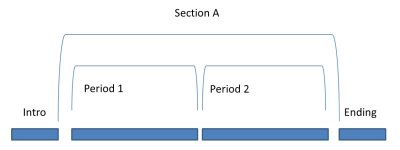murathan
Was a Bassoonist
Everything has a form in the universe. So musical pieces have a form too. Knowing these are very important in composing, but also important as a musician to understand, play and memorize a piece. There are 3 basic forms in that lesson.
1. One Period Form: Our first form is One Period One Section Form. There is one longer musical sentence. Nothing more. This is sort of coming short generally to make a lot of repeats. So changing the scale or style in a repeat is generally becomes necessary for not to get bored the listener.

Examples: Ciao Bella, Katyusha, Polyushka Polye
2. Lied (Means Song in German) Form: There are two sentences but they are similar. The second one is more important generally. Section A with two periods repeats itself but because there were 2 periods, it doesnt become boring. This form suits perfectly to poems. Because poems also being written in a form, suits this type of musical form generally.

Examples: All songs involving singer probably will be in that form. Pop music is based on this form either.
3. The A-B-A Form. Our next form consists of 3 sections. First the A section with its own character. Then the second section, different from the A section. That difference may be a change of scale, rhythm or melody but definitely doesnt look like the A section. Later A section repeats itself. Then the music ends or repeats from B section. Then A again and ends. This form is also very common in music.

Examples: Kalinka, Waves of the Danube, Korobeiniki (Tetris Theme)
Classical music uses these basic forms also but in much more complicated ways to make a long piece. Such as a symphony. They may have dozens of periods arranged in different ways, separated to 4 different parts in different metronome speeds, thus they can last a good 30 minutes without being boring.
I made this document and diagrams myself so there is no fear of copyright here
1. One Period Form: Our first form is One Period One Section Form. There is one longer musical sentence. Nothing more. This is sort of coming short generally to make a lot of repeats. So changing the scale or style in a repeat is generally becomes necessary for not to get bored the listener.

Examples: Ciao Bella, Katyusha, Polyushka Polye
2. Lied (Means Song in German) Form: There are two sentences but they are similar. The second one is more important generally. Section A with two periods repeats itself but because there were 2 periods, it doesnt become boring. This form suits perfectly to poems. Because poems also being written in a form, suits this type of musical form generally.

Examples: All songs involving singer probably will be in that form. Pop music is based on this form either.
3. The A-B-A Form. Our next form consists of 3 sections. First the A section with its own character. Then the second section, different from the A section. That difference may be a change of scale, rhythm or melody but definitely doesnt look like the A section. Later A section repeats itself. Then the music ends or repeats from B section. Then A again and ends. This form is also very common in music.

Examples: Kalinka, Waves of the Danube, Korobeiniki (Tetris Theme)
Classical music uses these basic forms also but in much more complicated ways to make a long piece. Such as a symphony. They may have dozens of periods arranged in different ways, separated to 4 different parts in different metronome speeds, thus they can last a good 30 minutes without being boring.
I made this document and diagrams myself so there is no fear of copyright here
Last edited:
